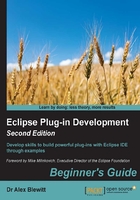
上QQ阅读APP看书,第一时间看更新
Summary
In this chapter, we covered how to get started with Eclipse plug-in development. From downloading the right Eclipse package to getting started with a wizard-generated plug-in, you should now have the tools to follow through with the remainder of the chapters of this book.
Specifically, we learned these things:
- The Eclipse SDK and the Eclipse IDE for Eclipse Committers have the necessary plug-in development environment to get you started
- The plug-in creation wizard can be used to create a plug-in project, optionally using one of the example templates
- Testing an Eclipse plug-in launches a second copy of Eclipse with the plug-in installed and available for use
- Launching Eclipse in debug mode allows you to update code and stop execution at breakpoints defined via the editor
Now that we've learned how to get started with Eclipse plug-ins, we're ready to look at creating plug-ins that contribute to the IDE, starting with SWT and Views—which is the topic of the next chapter.